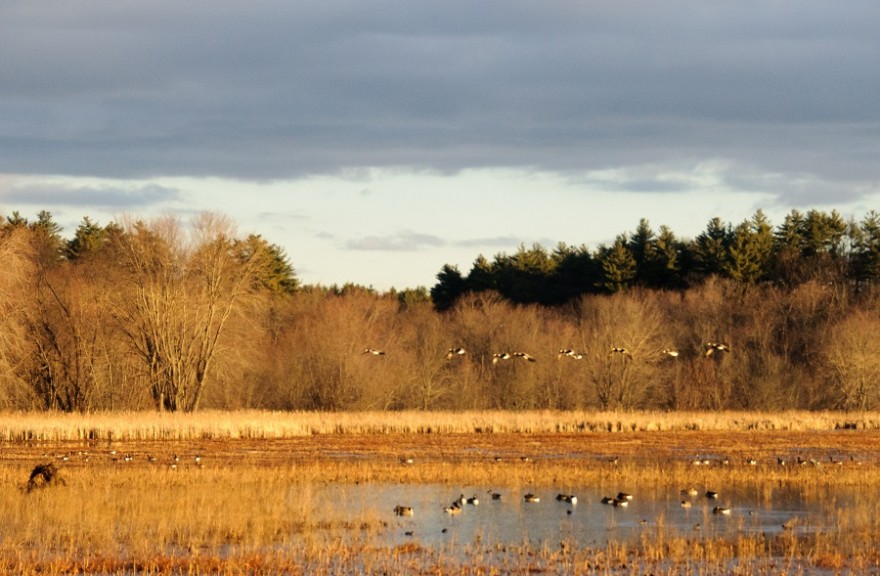
The Great Meadows National Wildlife Refuge in Concord, Massachusetts holds a host of trails and chance to see all kinds of wildlife. Image courtesy of Larry Warfield.
The songbird symphony fills the air. Breathe in the brined scent of the marsh. See the wind flutter through the woods while taking in a story told from silent signs.
Walking in nature isn’t only about climbing rugged mountains with loaded backpacks or trekking deep into the wilderness away from civilization.
Nature walks across New England are often found near the beaten path. Whether at a family-friendly Audubon site, national forest, or other property, there are low-key walks designed to educate, stimulate, and invigorate.
Many picture national forests as home to lofty peaks, and they are, but mellow nature walks on interpretive trails exist too.
And for those new to the outdoors with no wish for rugged remote forestlands but instead crave some convenience, they’re perfect. Here are seven great ideas for nature walks in New England that you can check out right now.
1. Great Meadows National Wildlife Refuge, Concord, Massachusetts
The impressive nearly 4,000-acre refuge along the Concord River managed by the US Fish and Wildlife Service is not only a fine spot for bird-watching but also an ideal locale for listening to nature’s soundtrack. The refuge’s original tract called “Great Meadows” in Concord off Monsen Road contains the Dike Trail, an easy ramble complete with a three-story observation tower, marshy pools and interpretive signs.
Bring binoculars to see raptors taking prey.
2. Ipswich River Wildlife Sanctuary, Topsfield, Masschusetts
Get birds-eye views of the marshy Great Wenham Swamp from the 30-foot high Bunker Meadows Observation Tower in the Ipswich River Wildlife Sanctuary in Topsfield on Perkins Row. The delightful Mass Audubon site has some 12 miles of hiking trails containing mowed pathways, narrow trails and more for plenty of woods walking within earshot of the sing-song of wildlife. From the handsome visitor center across the parking lot, take the Bunker Meadows Trail by the creative natural playground to water’s edge for an effortless ramble.
3. Fort Nature Refuge, North Smithfield, Rhode Island
The 235-acre Audubon Society of Rhode Island refuge contains a trio of numbered ponds, two of them with beaver lodges, and is known for its variety of plants and wildlife. Walkers can choose from well-signed and color-coded pathways along the roughly three-and-half-mile trail network.
See fisher, otter, porcupine, coyote, and much more. With a secluded feel in the deciduous and coniferous forests, the refuge attracts owls, wood ducks, egrets and other winged wonders.
4. Philbrick-Cricenti Bog, New London, New Hampshire
Wobble about a bit while walking the boardwalk in tundra-like Philbrick-Cricenti Bog in New London, New Hampshire about a mile west of town on Newport Road. Wander the kettle hole bog through a mile of loop trails in a wetland world of ferns, maples, sedge and stocky trees. Take the Peak Hole Loop to the wooden pole to see the depth of the peat mat and be sure to stick to the planks.
5. Sabbaday Falls, Albany, New Hampshire
About midway on the scenic Kancamagus Highway between Lincoln and Conway, New Hampshire, plunging Sabbaday Falls is reached via a relatively easy 15-minute walk in the White Mountain National Forest. The narrow cascades fall some 25 feet in a rocky setting complete with steps for a closer cooling look. The interpretive panels under the hardwoods tell of the formation of the falls, its pools and other geological features in a very refreshing spot.
6. Hamilton Sanctuary, West Bath, Maine
Thank birder and naturalist Millicent Hamilton for leaving the tucked away Hamilton Sanctuary to Maine Audubon. A one-and-a-half-mile trail network off Foster Point Road allows wonderful wandering along spruce and pine forests, by tidal flats, shorebirds, and through a grassy meadow. Well-marked paths, benches, and bridges add to the landscape with views to Back Cove.
7. Robert Frost Interpretive Area, Ripton, Vermont
Roam with Robert Frost’s poetry, interpretive signs, boardwalk, blueberries, and beaver pond along gentle short circuits within the Green Mountain National Forest off bucolic Route 125 between Routes 100 and 7.
The area is handicapped-accessible and is a place where people can learn about the work of Robert Frost as well as take in views, pick berries, see some birds, and maybe experience an occasional moose sighting.
Bring lunch for a picnic under the red pines and linger in the breeze.

 Your Privacy Choices
Your Privacy Choices